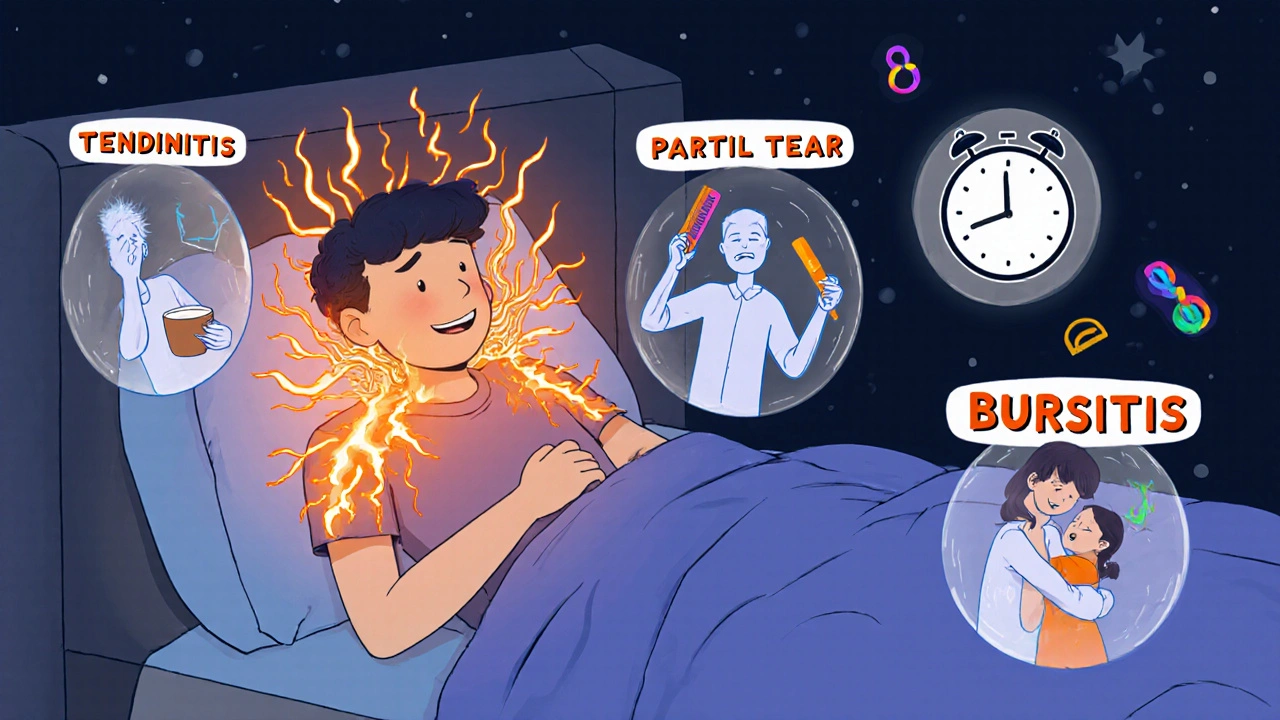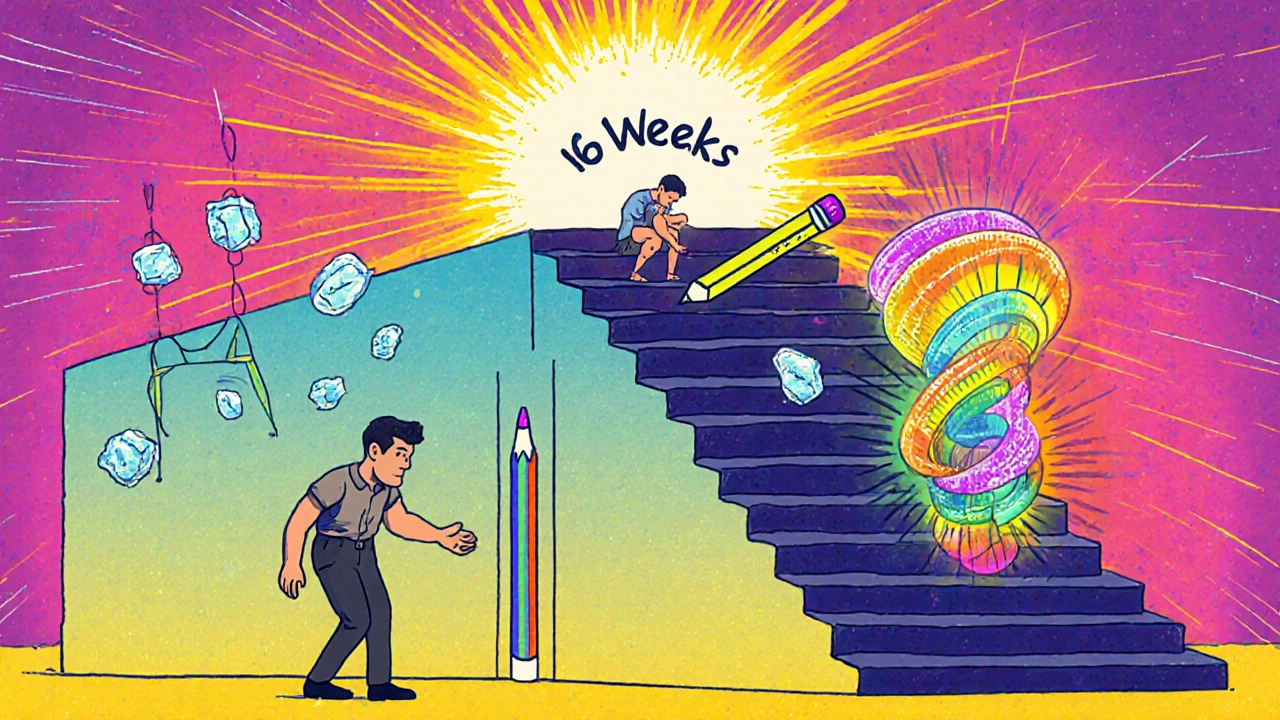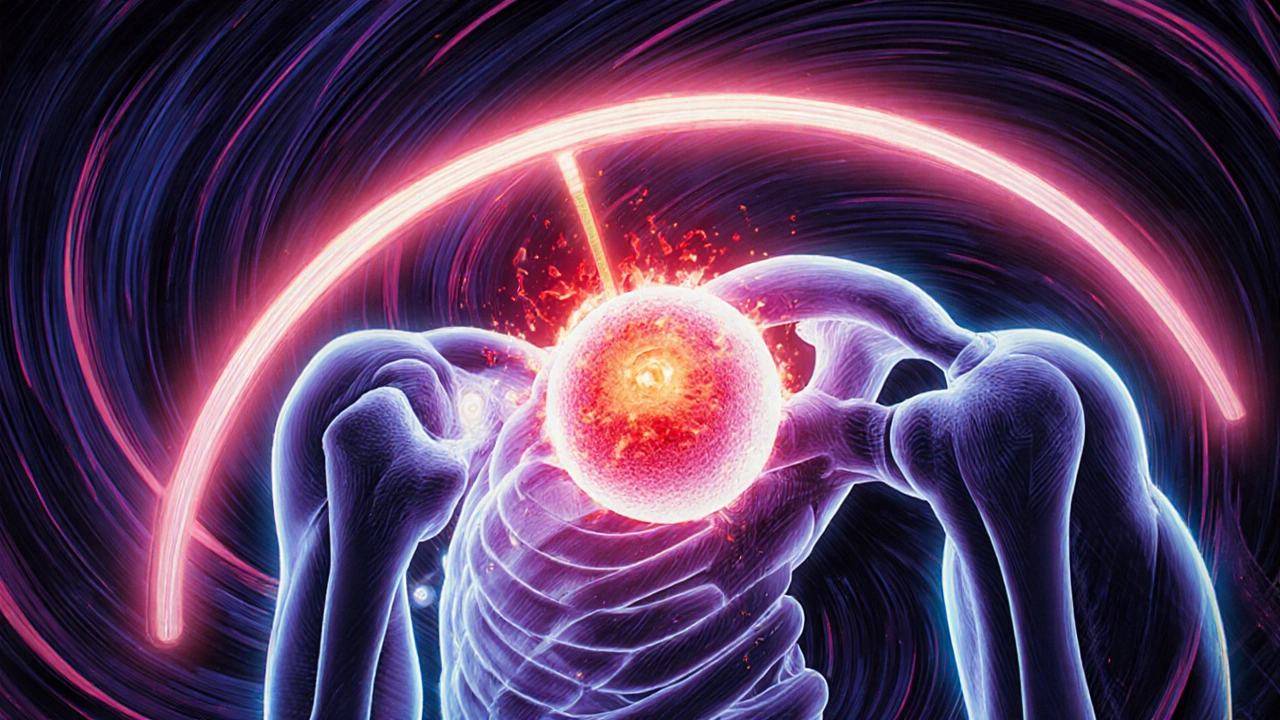Why Your Shoulder Hurts When You Lift Your Arm
Ever reach for a high shelf and feel a sharp, dull ache in your shoulder? Or wake up in the middle of the night because your shoulder feels like it’s on fire? You’re not alone. About 2 million Americans see a doctor each year for shoulder pain linked to the rotator cuff or bursitis. These aren’t just minor annoyances-they can stop you from sleeping, working, or even hugging your kids. And here’s the thing: most people try to push through it, ice it, and hope it goes away. But without the right approach, it just comes back.
The shoulder is a ball-and-socket joint, but unlike your hip, it’s built for movement, not stability. That’s why it’s so easy to mess up. Four small muscles-the supraspinatus, infraspinatus, teres minor, and subscapularis-hold the ball in place. They’re called the rotator cuff. Right above them is a fluid-filled sac called the subacromial bursa. Its job? To reduce friction. When that bursa gets inflamed (bursitis), or the tendons of the rotator cuff get irritated or torn (tendinitis or tear), they rub against the bone above them. That’s impingement. And that’s where the pain comes from.
What Rotator Cuff Pain Actually Feels Like
It’s not always a sudden snap or pop. Most of the time, it’s a slow creep. You notice it first when you reach behind your back to grab your seatbelt, or when you try to comb your hair. The pain isn’t sharp like a cut-it’s a deep, achy throb that gets worse when you lift your arm between 60 and 120 degrees. That’s called the painful arc. It’s a classic sign.
And yes, it gets worse at night. About 78% of people with these conditions report sleep disruption. Lying on the side hurts. Lying on your back makes the shoulder feel tight. You end up sleeping sitting up. That’s not normal. That’s your body screaming for help.
Age matters. After 40, your tendons start to lose elasticity. By 50, about 1 in 5 people have some rotator cuff wear. By 80, it’s more than half. But you don’t have to be old to get it. Construction workers, painters, tennis players, and even people who type all day with poor posture are at high risk. One study found construction workers have a 32% higher chance of rotator cuff problems than the general population.
Bursitis vs. Rotator Cuff Tear: How to Tell the Difference
People say "rotator cuff injury" like it’s one thing. But it’s not. There are three stages: tendinitis (inflammation), partial tear, and full-thickness tear. Bursitis is inflammation of the sac, but it almost always happens alongside tendinitis because they’re right next to each other. So if you have bursitis, you probably have some level of rotator cuff irritation too.
Here’s how to tell what you might be dealing with:
- Tendinitis: Pain when lifting, especially overhead. No weakness. Pain improves with rest and ice.
- Partial tear: Pain plus noticeable weakness. You might struggle to lift a coffee cup or reach behind your head. Night pain is worse.
- Full-thickness tear: You can’t lift your arm at all without help. The shoulder feels loose. Often happens after a fall or sudden pull.
- Bursitis: Swelling on the top of the shoulder, tenderness when pressed. Pain is more diffuse, not localized to one tendon.
Ultrasound or MRI can confirm it. But most doctors start with a physical exam. They’ll check your range of motion, strength, and pain triggers. If you can’t lift your arm past 90 degrees without pain, that’s a red flag.
The Real Rehab Plan (No Guesswork)
Here’s the truth: 80% of rotator cuff and bursitis cases get better without surgery-if you do the right rehab. Not the vague "do some stretches" advice you get from YouTube. Real rehab has structure, timing, and progression.
Phase 1: Pain Control (Weeks 1-2)
- Rest from overhead movements-no lifting, no reaching, no pushing.
- Ice the top of your shoulder 15 minutes, 3-4 times a day.
- Take NSAIDs like ibuprofen (400-600 mg, 3 times daily) for 7-10 days max. Long-term use can hurt your stomach and kidneys.
- Start pendulum exercises within 48 hours. Lean over, let your arm hang loose, and gently swing it in small circles. Do 5-10 minutes, 3 times a day. This keeps the joint moving without strain.
Phase 2: Restore Movement (Weeks 3-6)
- Begin active-assisted motion. Use your good arm to gently lift the sore arm overhead. Don’t force it. Just get it moving.
- Add wall slides. Stand facing a wall, place your fingers on it, and slowly walk them up as high as you can without pain. Lower slowly.
- Scapular retraction is critical. Squeeze your shoulder blades together like you’re trying to hold a pencil between them. Hold for 5 seconds. Do 3 sets of 15, twice a day. Patients who do this regularly recover 30% faster.
Phase 3: Strengthen (Weeks 6-12)
- Start resistance band exercises. Use a light TheraBand. Do external rotations: stand with elbow bent at 90 degrees, band anchored to a doorknob, pull band outward slowly. 2-3 sets of 15 reps.
- Internal rotations: same setup, pull band toward your belly.
- Side-lying external rotation: lie on your side, elbow bent, slowly lift hand toward ceiling. Keep your elbow glued to your side.
- Do these every other day. Overdoing it causes setbacks.
Most people see real improvement by week 8. But it takes 12-16 weeks to fully rebuild strength. Rushing it? That’s why 35% of people end up back in the clinic after a weekend of gardening or lifting boxes.

When Injections Help-And When They Don’t
If you’ve done 4-6 weeks of rehab and still can’t sleep or lift your arm, a corticosteroid injection might be next. It’s not a cure. It’s a reset button.
The injection-usually triamcinolone with lidocaine-is guided by ultrasound. That’s important. Without imaging, doctors miss the target 28% of the time. With ultrasound, accuracy jumps to 94%. The shot goes into the space between the bursa and the bone. It reduces swelling fast. Most people feel relief in 2-3 days.
But here’s the catch: you can only get 2-3 injections a year. More than that increases your risk of tendon rupture by 8%. And if you get the shot and then go back to lifting weights or painting ceilings? The relief fades fast. The injection gives you a window-4 to 12 weeks-to do real rehab without pain. Use it wisely.
Now, about PRP (platelet-rich plasma). It’s new. The American Shoulder and Elbow Surgeons now say it’s a good second option after steroids fail. In trials, PRP helped 68% of patients-better than repeat steroid shots. But it costs $500-$1,000 out of pocket, and Medicare doesn’t cover it yet.
Surgery: Is It Really Necessary?
Most people don’t need it. In fact, a major 2022 study in the Journal of Bone and Joint Surgery found no difference in outcomes between people who had surgery and those who did intensive physical therapy after 12 months. Both groups improved equally.
Surgery-usually arthroscopic subacromial decompression-is only recommended if you’ve tried 3-6 months of rehab and injections and still can’t function. It involves removing inflamed bursa tissue and shaving down part of the acromion bone to create more space. Recovery takes 4-6 months. You’ll be in a sling for 2-4 weeks. Physical therapy starts right away.
But here’s the kicker: if you have a full-thickness tear and you’re over 60, conservative treatment only works about 40% of the time. Surgery becomes a better bet. For partial tears or bursitis alone? Stick with rehab.
What Actually Works for Long-Term Relief
Here’s what patients who stay pain-free have in common:
- They use apps to track their exercises. One study found people who used reminders completed 82% of their rehab vs. 54% without.
- They avoid the "weekend warrior" trap. One day of heavy lifting after weeks of rest? That’s a recipe for flare-ups.
- They listen to pain. Not "no pain, no gain." But "don’t go over a 5 on a 0-10 scale." If it hurts more than a 5 during exercise, stop.
- They fix their posture. Slouching at your desk or hunching over your phone tightens the front of your shoulder and squeezes the bursa. Sit tall. Roll your shoulders back. Do it 5 times an hour.
And if you’re over 60? Blood flow restriction training-using a cuff to limit blood flow during light exercises-is showing promise. Mayo Clinic research found it cuts recovery time by 30% for older adults.

What Not to Do
- Don’t ignore night pain. It’s your body’s alarm.
- Don’t rely on massage or chiropractic adjustments alone. They might feel good, but they don’t fix the mechanics.
- Don’t skip physical therapy because it’s expensive. Medicare covers 58% of it for people over 65. Most private insurers cover 80%.
- Don’t assume you’re too old to recover. People in their 70s and 80s regularly regain full function with the right rehab.
How Long Until You Feel Better?
Realistic timelines:
- 2-4 weeks: Pain starts to ease with rest and ice.
- 6-8 weeks: Better movement, less night pain, you can sleep on your side.
- 10-12 weeks: Strength returns. You can lift groceries, reach overhead, and drive without discomfort.
- 16 weeks: Back to sports or heavy work-only if you’ve built up gradually.
If you’re not seeing progress by week 8, it’s time to revisit your doctor. Maybe you need imaging. Maybe you need a different rehab plan.
Can shoulder bursitis go away on its own?
Yes, but only if you stop the activities that caused it. Resting for a few days won’t fix it if you go back to painting ceilings or lifting weights the same way. Bursitis needs active rehab-strengthening, posture correction, and movement control-to truly resolve. Otherwise, it comes back.
Is heat or ice better for shoulder pain?
Ice for the first 48-72 hours, especially if the shoulder is swollen or hot to the touch. After that, heat can help loosen stiffness before stretching. But don’t use heat if you’re still in the acute pain phase-it can make swelling worse.
Can I still work out with shoulder bursitis?
Yes-but avoid anything overhead or pushing/pulling with the sore arm. Stick to lower body workouts, walking, or cycling. Once you’re past the first 2 weeks and pain is under control, you can slowly add light shoulder mobility work. Never push into pain.
How do I know if I have a rotator cuff tear?
Signs include sudden weakness, inability to lift your arm without help, and pain that doesn’t improve after 6 weeks of rehab. A full tear often happens after a fall or heavy lift. If you can’t hold your arm out to the side-even without weight-you should get an MRI. Partial tears can be managed with rehab, but full tears often need surgery, especially if you’re active or over 60.
Does posture affect shoulder pain?
Absolutely. Slouching shrinks the space between your shoulder blade and arm bone. That squeezes the bursa and tendons. Sitting up tall, pulling your shoulders back, and keeping your screen at eye level can reduce pressure on the shoulder by 40%. It’s not just about exercise-it’s about how you live all day.
What’s the fastest way to recover from shoulder bursitis?
Combine early motion (pendulum exercises), scapular strengthening, and consistent daily rehab. Patients who use phone reminders and do exercises every day recover 27% faster than those who don’t. Speed comes from consistency, not intensity.
Final Thought: This Is a Marathon, Not a Sprint
Shoulder pain from rotator cuff or bursitis doesn’t vanish overnight. It takes patience. It takes doing the boring stuff-every day. But it’s fixable. You don’t need surgery. You don’t need to live with pain. You just need a plan, consistency, and to stop ignoring the warning signs. The shoulder is resilient. But only if you treat it right.

Rachel Wusowicz
November 14, 2025 AT 18:03Ankit Right-hand for this but 2 qty HK 21
November 15, 2025 AT 11:49Oyejobi Olufemi
November 17, 2025 AT 11:48Daniel Stewart
November 18, 2025 AT 04:01Latrisha M.
November 19, 2025 AT 23:47Diane Tomaszewski
November 21, 2025 AT 15:12Dan Angles
November 23, 2025 AT 01:05David Rooksby
November 23, 2025 AT 21:56Melanie Taylor
November 24, 2025 AT 16:03Teresa Smith
November 25, 2025 AT 12:51